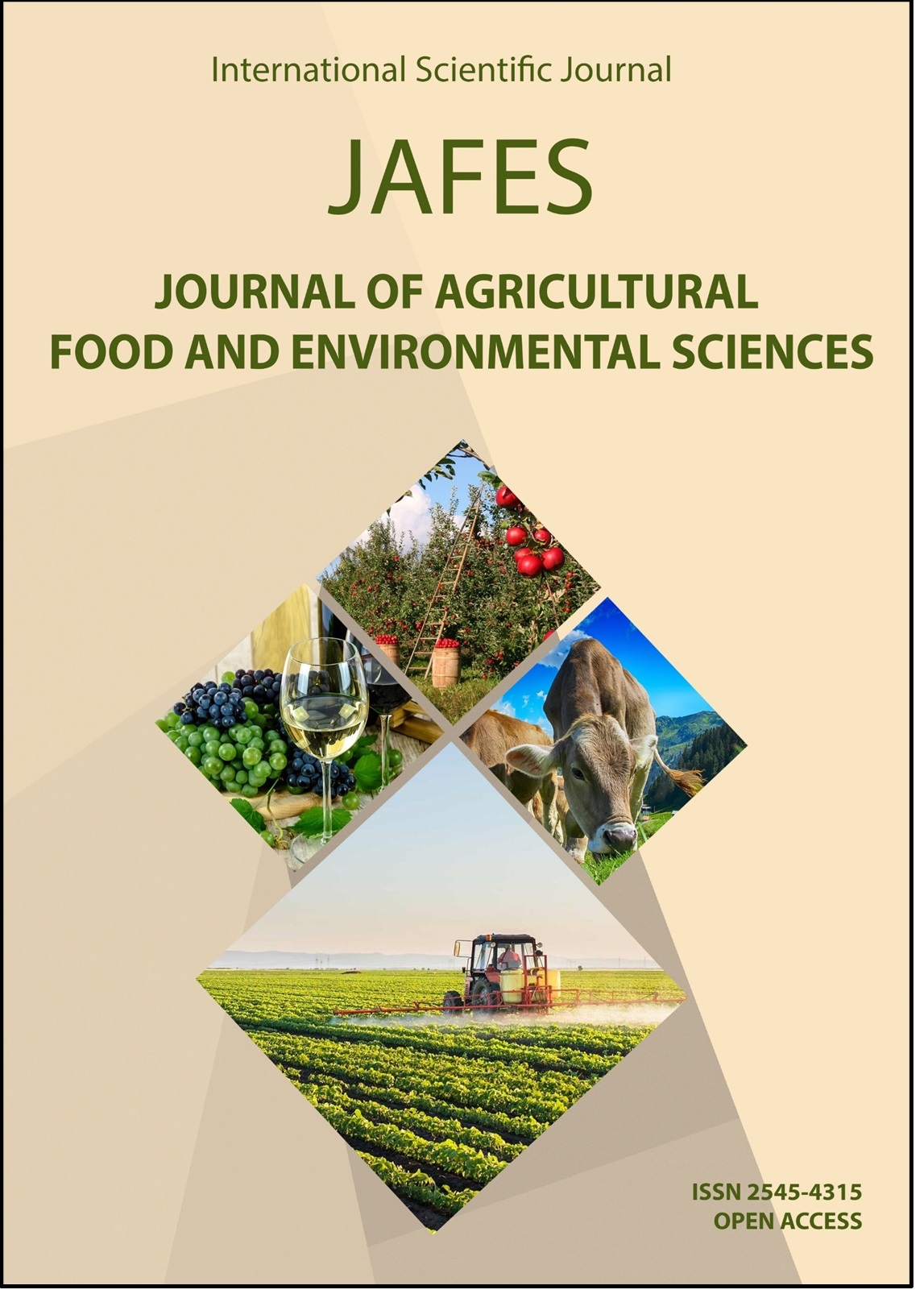THE DETERMINATION OF SOME AGRONOMIC AND OIL QUALITY CHARACTERISTICS OF PEANUT BREEDING LINES
Клучни зборови:
Peanut, breeding lines, agronomic characteristic, oleic acid and pod yield.Апстракт
This study was conducted as a main crop in University of Cukurova, Faculty of Agriculture Field Crops Department in 2016. The objective of this research was to determine some agronomic and quality characteristics of peanut breeding lines. In this study, 22 peanut lines (F6) belonging to Brantley (High oleic) x Halisbey (High yield) crossing were used as a plant material. The experimental design was a Randomized Complete Block with three replications. Pod number and pod weight per plant, 100-seed weight, shelling percentage, oil and protein content, saturated (Palmitic, stearic, arachidic and lignoceric acid) and unsaturated (Oleic, linoleic and linolenic acid) fatty acids percentage and pod yield per hectare values of lines were investigated. As a result, the pod number per plant of breeding lines was between 24.9-34.9 pod plant-1, pod weight was 73.3-91.2 g plant-1, 100-seed weight 118.0-148.6 g, shelling percentage was 59.5-66.9% and pod yield was 6064-9232 kg ha-1. The oil content and oleic acid percentage of breeding lines were varied between 41.20-55.95% and 51.97-80.00%, respectively.
Референци
Andersen, P.C. and Gorbet, D.W. (2002). Influence of year and planting date on fatty acid chemistryof high oleic acid and normal peanut genotypes. J. Agric. Food Chem. 50:1298-1305
Anonymous. (2016). The meteorological data for Adana. The Turkish State Meteorological Service Adana Regional Directorship, 2016
AOAC. (2010). Official methods of analysis of the association of analytical chemists. 18th Edition, Washington, D.C. USA
Arıoglu, H., Kurt, C., Bakal, H., Onat, B., Gulluoglu, L. and Sinan, N.S. (2013). The effects of pix (mepiquat-chloride) application in different gowing stages on pod yield and some agonomic characters of peanut. Turkish Journal of Field Crops, 18(2):260-267
Arıoglu, H., Bakal, H., Gulluoglu, L., Kurt, C. and Onat, B. (2016). Ana ürün koşullarında yetiştirilen bazı yerfıstığı çeşitlerinin önemli agronomik ve kalite özelliklerinin belirlenmesi. Tarla Bitkileri Merkez Araştırma Enstitüsü Dergisi, 25 (Özel sayı-2): 24-29
Brown, D.F., Carl, M.C., Karl, F.M. and James, G.D. (1975). Effect of variety, growing location and their interaction on the fatty acid composition of peanut. J. Food Sci.40:1055-1060
Caliskan, S., Caliskan, M.E., Arslan, M. and Arioglu, H. (2008). Effects of sowing date and growth duration on growth and yield of groundnut in a Mediterranean-type environment in Turkey. Field Crops Res. 105:131-140
Canavar, Ö. and Kaynak, M.A. (2010). Growing degree day and sunshine radiation effects on peanut pod yield and growth. African J. of Biotech, 9(15):293-301
Carrin, M.E. and Carelli, A.A. (2010). Peanut Oil: Compositional data. Eur. J. Lipid Sci. Technol., 112:967-707
Chowdhury, F.N., Hossain, D., Hosen, M. and Rahman, S. (2015). Comperative study on chemical composition of five varieties of groundnut (Arachis hypogaea L.). World j. of Agricultural Science 11(5)247-254
Cox, F.R. (1979). Effects of temperature on peanut vegetative and fruit growth. Peanut Science 6:14-17
Dwivedi, S.L., Nigam, S.N., Jambunathan, R., Sahrawat, K.L., Nagabhushanam, G.V.S. and Raghunath, K. (1996). Effect of genotypes and environments on oil and oil quality parameters and their cprrelation in peanut (Arachis hypogaea L.). Peanut Science 20:84-89
FAO. (2015). Production Year Book (www.fao.org).
Gulluoglu, L. (2011). Effects of growth regulator applications on pod yield and some agronomic characters of peanut in Mediterranean region. Turkish Journal of Field Crops. 16(2):210-214
Gulluoglu, L., Bakal, H., Onat, B., El Sabagh, A. and Arioglu, H. (2016a). Characterization of peanut (Arachis hypogaea L.) seed oil and fatty acids composition under different growing season under Mediterranean environment. Journal of Experimental Biology and Agricultural Sciences. DOI:http://dx.doi.org/10.18006/2016, 4(5S):564-571
Gulluoglu, L., Bakal, H., Onat, B., Kurt, C. and Arioglu, H. (2016b). The effect of harvesting dates on yield and some agronomic and quality characteristics of peanut grown in Mediterranean region (Turkey) Turkish Journal of Field Crops. 21(2): 224-232 (DOI:10.17557/tifc.20186)
Isleib, T.G., Tilman, B.L., Patte, H.E., Sanders, T.H., Hendrix, K.W. and Dean, L.O. (2008). Genotype-by-environment interaction for seed composition traits of breeding lines in the uniform peanut performance test. Peanut Science 35:130-138
Ketring, D.L. (1984). Temperature effects on vegetative and reproductive development of peanut. Crop Sci. 24:877-881
Kurt, C., Bakal, H., Gulluoglu, L. and Arioglu, H. (2017). The effect of twin row planting pattern and plant population on yield and yield components of peanut (Arachis hypogaea L.) at main crop planting in Cukurova region of Turkey. Turkish Journal of Field Crops, 22 (1):24-31DOI: 10.17557/tjfc.301768
Mzimbiri, R., Shi, A.E., Liu, H. and Wang, Q. (2014). A Review: peanut fatty acids determination using hyper spectroscopy imagine and its significance on food quality and safety. Food Science and Quality Management 28:90-97.
Savage , G.P. and Keenan, J.I. (1994). The composition and nutritive value of groundnut kernel. In Smart, J. (ed) The Groundnut Crop: A scientific basis for improvement. Chapman and Hall, London, pp 173-213
TUIK, (2015). Turkish Production Year Book.



